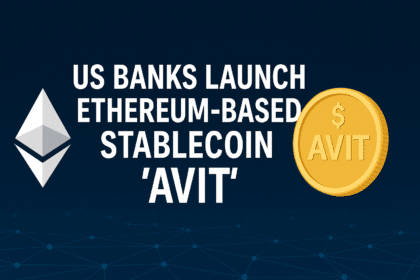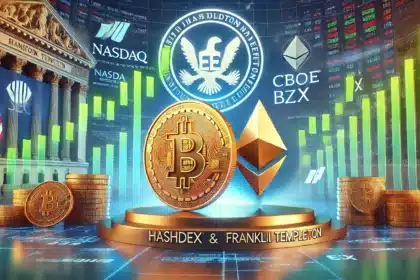Ethereum is gaining powerful momentum from two very different but complementary forces: traditional institutional finance and emerging artificial intelligence applications. According to CoinDesk’s Asia Morning Briefing, ETH’s price has surged past $2,770, up over 11% since early June. Meanwhile, institutional investors now dominate 45% of Ethereum’s perpetual futures volume, even surpassing Bitcoin’s 38%—a rare shift that signals growing preference for ETH as a strategic asset.
But it’s not just finance fueling the rally. A new wave of AI agents, autonomous digital services built on artificial intelligence, is beginning to use Ethereum as a settlement layer, interacting with blockchains for microtransactions, data verification, and even decentralized collaboration.
Together, these developments are redefining Ethereum’s market narrative—from a decentralized application layer to a core component of digital economic infrastructure.
Institutional Buyers Are Driving the Price Action
ETH’s impressive rebound is not just technical, it’s capital-driven. Analysts point to a sharp rise in institutional capital flows through ETH futures, ETFs, and direct spot positions. Since early 2025, Ethereum has increasingly become the preferred vehicle for institutional DeFi exposure, particularly after the SEC approved multiple ETH-based ETF products in April.

According to Lennix Lai, Chief Commercial Officer at OKX:
“Ethereum’s use case extends far beyond speculation. It’s becoming the settlement layer between traditional finance and blockchain-based liquidity.”
Ethereum’s ability to support stablecoins, tokenized assets, and complex financial primitives makes it more versatile than Bitcoin, particularly for asset managers looking to bridge into DeFi.
In fact, Bitwise recently reported that Ethereum now processes more institutional stablecoin volume than SWIFT-linked banking rails, an astonishing benchmark that underscores ETH’s real-world utility.
ETH Technicals Show Bullish Breakout Potential
Ethereum’s price currently sits around $2,770–$2,800, up over 11% for the month and outpacing Bitcoin’s 5% gain. The technical outlook is increasingly bullish:
ETH has cleared both its 10-day and 50-day EMAs
RSI is hovering around 68, approaching overbought territory, but suggesting strong upward pressure
ADX (Average Directional Index) is at 24, confirming a strengthening trend
If ETH can close convincingly above $2,880–$2,900, analysts expect a test of the $3,000 psychological barrier—a level not seen since early February.
AI Agents Now Tapping Ethereum for Value Exchange
In a new and surprising twist, AI agents, autonomous software bots powered by machine learning, are beginning to integrate Ethereum smart contracts into their operational workflows. These AI-driven agents are leveraging blockchain for:
Permissionless payments between systems
Data timestamping for credibility and verifiability
Coordination between decentralized services like oracles, cloud storage, and processing
This signals a profound shift in the way digital infrastructure will evolve. Ethereum is no longer just a chain for DeFi apps or NFTs; it is becoming the core protocol for AI-to-AI value exchange.
CoinDesk’s report highlights early use cases where AI agents autonomously interact with decentralized financial contracts, prediction markets, and peer-to-peer computation protocols using ETH-based microtransactions.

ETH as the Operating System for the AI Economy?
While still early, the synergy between Ethereum and artificial intelligence is being noticed by both developers and institutional investors. As AI models get smarter and more autonomous, they need secure, decentralized payment rails—something Ethereum uniquely provides.
Blockchain strategist Paul Brody from Ernst & Young said:
“Ethereum is quickly evolving into the internet’s financial backend. If AI is the new front-end intelligence layer, Ethereum may very well be the back-end trust layer.”
This structural development could set the stage for exponential adoption in coming years, as AI workloads expand and automation requires direct, on-chain settlement.
ETH vs BTC: Changing Guard?
The crypto market’s attention has long been dominated by Bitcoin—but Ethereum is clearly carving out its own narrative. With greater utility, faster adoption in financial products, and now new use cases via AI, Ethereum is emerging as a foundational digital asset, not just an altcoin.
Institutional traders are starting to reflect this reality in their strategies, allocating larger ETH-weighted positions in structured portfolios, ETFs, and managed crypto funds.
If current momentum continues, ETH could enter Q3 2025 as the best-performing major crypto, overtaking BTC in ROI terms for the first time in over a year.
Conclusion: Ethereum’s Next Frontier Isn’t Just Financial, It’s Cognitive
Ethereum is no longer just DeFi’s foundation. It’s fast becoming a crossroad between global finance and autonomous intelligence. With institutional traders stacking ETH and AI agents tapping smart contracts for automation, the $3,000 breakout may be less about hype and more about function.
As capital, computation, and intelligence converge on-chain, Ethereum’s role in the crypto economy looks more inevitable than speculative. Whether it’s Wall Street or machine agents doing the buying, one thing is clear: Ethereum is no longer waiting to lead; it already is.
Frequently Asked Questions (FAQs)
What’s driving the recent price surge in this crypto asset?
A combination of institutional buying and AI-driven demand is fueling its upward momentum.
How are AI agents using blockchain?
They’re using smart contracts for payments, automation, and decentralized coordination.
Why are institutions favoring this over Bitcoin?
It offers more utility—supporting DeFi, stablecoins, and AI integrations—beyond just being a store of value.
Glossary of Key Terms
Institutional Buying – Investments made by large financial entities like hedge funds, asset managers, and banks.
AI Agents – Autonomous software programs powered by artificial intelligence that can make decisions and perform tasks independently.
Smart Contracts – Self-executing agreements written in code, deployed on blockchains.
Perpetual Futures – Derivative contracts with no expiry, used by traders to speculate on price movements.
Blockchain Rails – The underlying infrastructure that allows digital assets to move and be recorded securely.





























